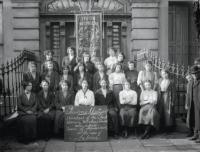Irish Women’s Franchise League and Irish Women’s Workers’ Union
Published in 20th Century Social Perspectives, 20th-century / Contemporary History, General, Home Rule, Issue 1(Jan/Feb 2013), Reviews, Volume 21
Members of the Irish Women’s Workers’ Union on the steps of Liberty Hall, c. 1914. (NLI)
Hannah and Francis Sheehy-Skeffington and Margaret Cousins founded the radical Irish Women’s Franchise League (IWFL) in 1908; Hanna was elected chairwoman and Meg Connery served as vice-chairwoman. The IWFL was the most outspoken and public manifestation of women’s discontent and radical feminism in Ireland. Its primary aim was to secure women’s suffrage within Home Rule.
The Irish suffrage movement expanded to include the Conservative and Unionist Women’s Franchise League, the Munster Women’s Franchise League, the Irishwomen’s Suffrage Federation, the North of Ireland Women’s Suffrage Committee, the Irish Women’s Suffrage Society and the Irishwomen’s Suffrage and Local Government Association (IWSLGA). The IWSLGA was probably the best known of the various organisations. Unlike the multiplicity of sectarian groups, it attracted both nationalists and unionists but was strictly non-militant, focusing on petitions, meetings and letters to the press to forward its demands. Sheehy-Skeffington and Cousins believed that the IWSLGA was too ‘genteel’ to make any significant impact on Irish society.
By 1911, the number of suffrage societies prompted Louie Bennett and Helen Chenevix to set up the Irish Women’s Suffrage Federation to coordinate the various efforts. On 22 August 1911, 3,000 women at Jacob’s biscuit factory went on strike. The Irish Times reported that
‘. . . the [male] strikers were reinforced by some 3,000 girls . . . The girls admitted that they themselves had not struck from any grievance to themselves, but only out of sympathy with the men.’
Nevertheless, that the women were as militant as the men was illustrated by the experiences of Roseanne (Rosie) Hackett. An employee at Jacob’s, she was one of the most militant in the 1911 strike, was locked out in 1913 and was unable to get employment thereafter. The Jacob’s strike was the first major industrial dispute involving women workers in the city. And in the Lockout of 1913, women from Jacob’s factory were described as amongst the most militant, and they utilised their organisational skills to run mass soup kitchens at Liberty Hall.
Concurrent with the suffrage issue was the need to protect the rights of women. The Irish Women’s Workers’ Union (IWWU) was launched on 5 September 1911, with James Larkin as president and his sister Delia as general secretary. Larkin decided that membership in the Irish Transport and General Workers’ Union (ITGWU) was reserved to men, and the IWWU was formed on the principle that women workers needed their own union. The union claimed 1,000 members by 1912.
For some republican women, it was also becoming clearer that there were other issues besides votes for women and freedom from British rule, in particular the poverty endured by the Irish majority. Like other suffragists, they felt that women should not champion the cause of Irish independence if in an independent Ireland they remained disenfranchised. Nationalist women believed that women’s suffrage while Ireland remained under British rule would not liberate Irish women but would simply provide them with a voice in a parliament whose legitimacy they did not recognise. Republican women appealed to supporters of women’s suffrage to join their struggle against British rule. The Daughters of Ireland newspaper, Bean na hÉireann, editorialised:
‘Hitch your wagon to a star. Do not work for the right to share in the government of that nation that holds Ireland enslaved, but work to procure for our sex the rights of free citizenship in an independent Ireland.’
By 1916 many members of the IWWU and the IWFL had joined the Irish Citizen Army or Cumann na mBan, and over 250 participated in the Rising itself. HI
Joseph E. Connell is the author of Dublin in rebellion: a directory, 1913–1923 (Lilliput Press, 2006).
Further reading
M. Jones, These obstreperous lassies: a history of the Irish Women’s Workers’ Union (Dublin, 1988).
S. McCoole, Guns and chiffon (Dublin, 1997).
S. McCoole, No ordinary women: Irish female activists in the revolutionary years (Dublin, 2003).
'
















